![]()
![]()
![]()
![]()
| Discovering Our
Mezzojuso Ancestry & Heritage
|
||
| Article 2 by Salvatore Joseph Lagattuta |
![]()
![]()
![]()
![]()
![]() Music: "Una
Lacrima sul Viso" -
by Bobby Solo
Music: "Una
Lacrima sul Viso" -
by Bobby Solo![]()
![]()
![]()
![]()
![]()
![]()
![]()

![]()
![]()
![]()
Salvatore Joseph Lagattuta - - - E-mail: slagattu@gte.net
| "Remembrance of Visiting Mezzojuso (during the Summer of 1969)"; |
| written on 26 April 1997. |
![]()
![]()
![]()
![]()

![]()
![]()
![]()
![]()
![]()
![]()
![]()
"Remembrance of Visiting Mezzojuso (during the Summer of 1969)";
written on 26 April 1997.
During mid July to early September of 1969, I (as a teenager) and my family -- my parents, Mario Lagattuta and Domenica (La Barbera) Lagattuta, and my two younger brothers Nicky and Tony, and my much younger sister Connie -- visited Mezzojuso, the Sicilian town where I was born in 1952.
From that small mountain village, I and my younger brother Nick (both born in Mezzojuso, as were our parents) had been taken as infants, by our parents, in order to immigrate to the United States. I was nearly three years old way back then in March of 1955.
As teenagers, I and my brother Nicky held no clear recollections of the first few years of our lives in Mezzojuso, not even any conscious feelings or thoughts about the place. My brother Tony and my sister Connie were born in the United States. Of course, while we were growing up in Garfield, New Jersey, our parents, who were raised and married in Mezzojuso, Sicily, always told us interesting stories about the people and places of Mezzojuso, which seemed so far away and almost mythical. Additionally, all of our close paternal relatives had moved to Garfield, New Jersey, during the mid 1950s from Mezzojuso, so that we had a lot of family with recent roots from Mezzojuso. Nearly all our maternal family members still lived in or near to Mezzojuso. We did occasionally exchange phone calls, postal mail and packages with our maternal relatives in Mezzojuso.



Our Family in June 1969, shortly before we traveled together to Mezzojuso
| Standing: our parents, Mario Lagattuta and Domenica (Mimidda) La Barbera, |
| and my younger brother Nicoló (Nicola, Nicholas, Nicky) |
| Sitting: me Salvatore (Salvuccio, Sal), my younger sister Concetta (Cettina, Connie), |
| and my youngest brother Anthony (Antonino, Nino, Tony) |
In mid July of 1969, my parents and I and my younger siblings traveled on our first airplane trip, from Kennedy airport in New York City to Punta Raisa airport near Palermo. After experiencing a brief though very emotional welcome by some of my maternal relatives at the Punta Raisa airport, they drove us quickly (I thought too fast in their small European cars over those meandering Sicilian country roads) to our fabled ancestral village of Mezzojuso!!!
Upon first entering Mezzojuso in the evening twilight of that summer day, we were driven through its narrow winding streets and into the main plaza, known locally as "la chiazza" or officially as Piazza Umberto Primo (Humbert the First Plaza). This central plaza was dominated by two large churches, next to each other, which (I was told) were both Catholic churches but of different rites: "Maria Santissima Annunziata" (Most Holy Mary of the Annunciation), of the Roman Rite; and "San Nicola di Mira" (Saint Nicholas of Mira), of the Byzantine Rite. Their respective liturgical languages then were Latin and Greek; hence, they were of the Latin Rite ("il rito latino"), and of the Greek Rite ("il rito greco"), respectively.

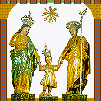
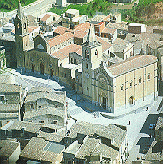
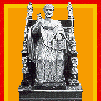

| "Piazza Umberto Primo" -- "La Chiazza": |
| with Mezzojuso's two Matriarchal Catholic Churches |
[Left] Most Holy Mary of the Annunciation -- of the Latin / Roman Rite; that was rededicated in 1572, and founded by the Normans about 1072 as the church of Most Holy Glorious Mary (upon an earlier Arab mosque)
[Right] Saint Nicholas of Mira -- of the Greek / Byzantine Rite; that was founded by the Italo-Albanians [Arbėresh] in 1516 (upon an earlier Norman-Swabian watchtower, that was previously an Arab minaret)
That first evening in Mezzojuso, even though my parents and my younger siblings and I were very tired from our lengthy airplane flight from the U.S.A. to Italy, we stayed up nearly the whole night long, talking with our numerous maternal relatives. My mother was especially happy, because she had not seen any of her family members in person for nearly 15 years (since early 1955). For her, it truly was a wonderful family reunion, shedding many tears of joy to see them all again. One of the reasons that my parents had decided to travel to Mezzojuso was because my mother's father had died during the previous year, and my mother deeply wished to see her folks.
Trying to speak our limited Sicilian as best as we could, I and my younger siblings were tremendously excited, as we became acquainted with our very, very numerous maternal relatives. I myself was especially pleased finally to know personally my nonna Giuseppina, about whom I had heard so much, ever since I was growing up as a small child.
My mother, Domenica La Barbera Lagattuta, was one of 8 children born to my maternal grandparents, Nicoló La Barbera and his wife Giuseppina. [My maternal grandmother was given the name Giacoma Ginetti, at a convent in Palermo, where her birth parents (reportedly from Naples) abandoned her as a week-old infant; within another week, my great-grandfather, Liborio La Barbera and his second [barren] wife Lucia Bidera, decided to adopt this little baby girl and named her as Giuseppa La Barbera.]
I and my younger brothers and sister had the wonderful opportunity to meet our maternal grandmother, nonna Giuseppina. Unfortunately, we never had the chance to know our maternal grandfather, nonno Cola, who had died exactly on his 83st birthday -- 1 January 1968, about a year and a half before our visit to Mezzojuso. Our maternal relatives were so kind as to give us some photographs of him, with his numerous family members, dating from 1966.



| My maternal grandparents: |
| Nicoló La Barbera and Giacoma Ginetti, |
| nonno Cola and nonna Giuseppina; |
| with their many relatives in Mezzojuso, during 1966. |
I distinctly remember from that summer of 1969 that in Mezzojuso there were relatively few cars, which hobbled over the cobblestone streets, where occasionally some goats and sheep and chickens ambled contentedly. At times, the entire village seemed to carry the distinctive odors associated with such farm animals. The street lights at night were more like hung lamps that shed pyramids of luminescence around "la chiazza" and on some sections of the major streets in the town. Most of these streets were quite narrow, and some were even steep and curvy, meandering about the various sections of town. Mezzojuso truly had the look and feel (and sometimes the pungent smells!) of a town that had developed as a sprawling Medieval country village -- with its multi-storied houses connected to each other, in their small apartment-like blocks. Although some public buildings and houses were of dressed local stone, most had facades of stucco, painted in various pastel colors.
I recall that the "Mezzojusari" villagers always gathered together in "la chiazza" during the mornings and evenings (but not during the hot afternoons, a sort of siesta time). Curiously, the men in their customary dark-hued jackets and caps, ambled about on their "passegiati", their continuous walking back and forth, almost incessantly trooping around "la chiazza", while the women usually stayed in their separate small stationary groups talking and gossiping about thus-and-such.
|
My brothers and male cousins and I, as teenagers, frequently used to enjoy playing soccer in the sports field, along the main road leading up to the village of Mezzojuso. During the hot and dry summer months, the soccer field consisted more of dusty patches than of sturdy green grass.
We guys also liked hiking into the nearby woods, playing at an old dilapidated mill called "il mulino Trazerra". We often climbed up the nearby, long stony stairs that led past the little hill-side chapel of "la Madonna dell'Udienza" and onward toward the summit of mount "la Brigna", with its terrific panoramic view of the entire village of Mezzojuso!
We guys, along with our girl cousins, and our friends in Mezzojuso, very much enjoyed talking amongst ourselves about what all teenagers like to talk about, and listening to the radio or to records of popular rock-and-roll music -- Italian, American and British -- and I still have some 45-speed vinyl records from that time, including one of my favorite romantic songs, that is called "Rose Rosse" (which begins with the lovely lyric: "Rose rosse per te, ho comprato sta sera..." - "Red roses for you, I have bought this evening..." )
|
A couple of times during those cool summer nights (when you needed to wear a light sweater, as compared to the extreme dry heat of the day), it seemed like the entire village of Mezzojuso turned out for the public movies shown in "la chiazza". It was a relaxing and nearly festive mood, with the "younger kids" (rather than us teenagers) being rambunctiously loud, especially during the high-points of the movies (usually a romantic scene), and all the old ladies ("le nonne") used to scold them to silence -- "Zitti, zitti, mascarati!" -- "Quiet, quiet, you rascals!"
Some "Mezzojusari" (such as some of my maternal relatives, especially my maternal grandmother Giuseppina La Barbera) used to bake bread daily in their "pizza ovens" (hearths in the homes, constructed of bricks and stoked with dried wood and brambles from the nearby "la Brigna" woods). We all would enjoy delicious, home-made breads and sometimes "biscotti" cookies, too -- with our strong "Sicilian" coffee. Every so often, we were delighted to be served the most delicious pizza, with home-made sauce and herbs and pristine olive oil sprinkled atop the freshly-made baked dough. Tasty home-made wines were always served with meals, although I preferred to drink the tart Italian-style sodas of orange or lemon-lime flavors.
|
Mezzojuso food was very wholesome. There was a good amount of fresh milk, and soft delicate ricotta, as well as some rather strong-smelling hard cheeses, with home-made or regional wines, and with fresh fruit in season. I particularly relished the cactus pears called "ficudinni" in Sicilian (but in Italian are called "fico d'India" or figs from India), and the really tasty freshly-picked tomatoes and cucumbers and squashes and herbs. Of course, spaghetti was frequently served, in a wondrous variety of shapes and sauces. Meat was customarily not often served, but while we stayed in Mezzojuso with my maternal relatives, my father (Mario Lagattuta) insisted on purchasing some daily (from one of his La Gattuta cousins, who was a "beccajo," a butcher; apparently, the La Gattutas have been known for generations as being the butchers in Mezzojuso!!!).
"Mezzojusari" now boast about their "famous" one traffic light, at the main road entering the north-east corner of "la ghiazza", between the back-side of the church of Saint Nicholas of Mira and the Municipal Town Hall across the narrow street. There used to be three traffic lights, my cousins now tell me; however, in 1969, there were no traffic lights and not many cars.
I believe that in 1969 there were much more horses than cars, because I recall that a lot of the men used to ride out on horseback in the early mornings, sometimes coming home for lunch, and then returning in the evenings, from their fields and gardens surrounding the village. Also, herders of sheep and goats and cows could be seen from the outskirts of the village, tending their flocks in the hillsides and traveling even further away.
.
. |
My maternal uncle Liborio La Barbera once took me and my two brothers (Nicky and Tony) on horseback ("supra mule") to the La Barbera family plot "in campagna" (out in the country). We rode on our four horses for about a half-hour slow ride out of town, over country paths and past many well-kept fields and gardens. My brothers and I tremendously enjoyed this fun-filled horseback outing to the country, although my brother Tony got bitten by a tick on the way home, and the tick had to be "burned off" by a heated matchstick, in order for the tick to release safely the grip of its pernicious jaws.
In and around Mezzojuso were some fascinating animals. We used to see the color-changing chameleons that seemed to be scurrying about everywhere, in the streets, up the walls of houses, and in the paths around the village and at mount "la Brigna", to whose summit we often hiked. Every so often, we encountered some bull-frogs (really big ones) near the "mulino Trazzera", the old dilapidated 'mill' where we would sometimes play, making believe that it was a castle that we were protecting. Very rarely, thankfully, did we see some snakes and scorpions, that we assiduously avoided, although one of my cousins had the unusual habit of trying to catch snakes with two forked sticks, just to see if he could capture them. Strange and colorful butterflies and moths and various insects abounded, as well as a great variety of birds, some plainly hued but others in bright, outlandish colors.
Plants were also interesting, some being sub-tropical, such as cacti and ferns, but also some deciduous trees like quinces and holm oaks, as well as evergreens like spruces and firs. There were many kinds of fruit-bearing trees (like chestnuts, almonds, apples, pears, cherries, pomegranates, nespoli, etc.) and various berry bushes. Additionally, the gardens in and near to Mezzojuso, "i giardini", consisted of various potted herbs (such as basil, parsley, mint, oregano, etc.) and vegetables (such as tomatoes, cucumbers, squashes, eggplants, peppers, melons, lapisani, etc). Wildflowers were in their myriad's, particularly in the woods of "la Brigna", with many crocuses, lilies, poppies, daisies; and there were various bamboo-like canes, and many kinds of thorny brambles.
 |
|
 |
Above is a thatched shelter (Il Pagliaio) in the woods near Mezzojuso.
![]()
Learning About the History and Culture of Mezzojuso
![]()
While I was vacationing in Mezzojuso with my family during the summer of 1969, I learned a great deal about the unique history and culture of my ancestral home-town.
Geographically speaking, the comune of Mezzojuso is located in the central heart of the Palermo province. It is actually situated on the northern plateau of the double-peaked mount called "la Brigna", which derives etymologically from the Italo-Albanian (Arbėresh) word "brignat", meaning 'horns' in English.

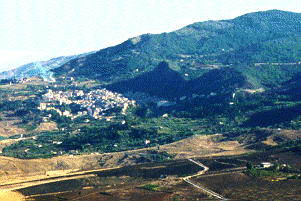

Mezzojuso is located on the northern platerau of mount "la Brigna".
In terms of increasingly higher elevations are: the fertile Scorciavacca fields, the streets of Mezzojuso, the doubled-peaked mount La Brigna, the fertile fields of La Lacca, and the distinctive twin-peaks of Il Monte Marabito and Il Pizzo di Casa -- the highest elevations at the southern-most part of Mezzojuso's territory, at the eastern-most edge of the extensive La Rocca Busambra mountain range.
To the west of streets of Mezzojuso is the wonderful natural beauty of the majestic Rocca Busambra mountain range. Its summit (only seven miles from Mezzojuso) is the highest point in all of western Sicily, which can be seen looming up, as viewed from atop mount Il Pizzo di Casa, the highest point within the territory of Mezzojuso.

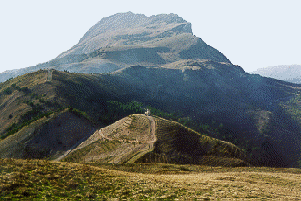

La Rocca Busambra and La Ficuzza, as seen from the atop Il Pizzo di Casa
This view (looking west) is of the vast nature reserve of La Rocca Busambra and of the lush La Ficuzza forest. Mezzojuso's territory is on the rain-capturing northern slope (to the right of the photos above). The La Ficuzza forest is also on the verdant northern side of these lofty cliffs (at the right side of the photos above). On the southern side are the drier foothills (to the left of the photos above). Notice the winding road going up to the Ranger Station at the summit of the lower, intervening mount.
Mezzojuso is actually located on a geological water-table, where many fresh water springs emerge, such as the spring which supplies its water to the large and old water fountain, "la fontana vecchia", in front of my maternal grandmother's house. At that time (1969), there were many other smaller water fountains throughout the village of Mezzojuso, as well as several "beviraturi" or "water troughs" for the animals.
A small stream (called "il fiume Trazzera", with hardly any water in the summer) is at the western edge of the comune of Mezzojuso, where there stood the old grain-grinding mill (called "il mulino Trazzera") with a wooden water-wheel, apparently disused and abandoned for a very long time. This little stream flowed out into a valley north of Mezzojuso, then continuing on into the San Leonardo River that empties into the Mediterranean Sea, at the northern-coastal Sicilian port city of Termini Imerese.
I recall that lots of people from the surrounding villages used to drive into Mezzojuso during a "hot spell" during that summer of 1969, to fill up their large containers with fresh cool water from the old fountain, "la fontana vecchia", just outside of my nonna Giuseppina's house, and which (as tradition says) has never run dry. Perhaps that was why the early hermits of the nearby Greek-rite monasterychurch had come to this place, well before the Byzantine-rite Albanian soldiers and their families arrived at Mezzojuso during the 1460s.
At some time around the year 1000, the Saracen Arabs founded this village and they named it as "Manzil Jusuf", which in Arabic means "the village of Joseph," although that may actually be pre-dated by the Arabic term of "Manzil 'iusu", which in Arabic means "the ancient village."
Apparently, in about 1050, the Arabs built a castle, now called "Il Castello Vecchio" (that is, "the Old Castle"). For many centuries, this old castle at the western boundary of Mezojuso's central plaza was used successively as one of the main public buildings in the village by Mezzojuso's various rulers: the Arabs (ca. 1000-1072), the Normans (1072-1132), the Benedictine monks (1132-1523), the local managers representing the Corvino noble family (1527-1832), and the local politicians that were appointed (1832-1860) and then elected (1860 onwards).
|
|
| The Old Castle: the most ancient structure of Mezzojuso; |
| Constructed about 1050 A.D., during the Saracen Arab period. |
While in Mezzojuso during that summer of 1969, I was told that as the result of a monetary legacy granted by the Arbėresh noble Andrea Reres, the Byzantine-rite Catholic monastery ("Il Monastero Basiliano") was attached (in 1609) to Mezzojuso's most ancient Byzantine-rite church of Most Holy Mary of All Graces, "Maria Santissima di Tutte delle Grazie". This church is just down the street from where most of my maternal relatives live in Mezzojuso; and although of the Latin rite, they would often attend liturgies at the Greek-rite "Santa Maria". This church, whose papįs welcomed the initial Albanian settlers to Mezzojuso during the 1460s, purportedly pre-dates by centuries the matriarchal Byzantine-Rite church of "San Nicola di Mira", built on the northern perimeter of "la chiazza" in 1516 by the Arbėresh (Italo-Albanians), upon the remains of an earlier Norman-Swabian watchtower, that even previously had been an Arab minaret.
|
|
|
| Most Holy Mary of All Graces previously called Most Glorious Virgin Mary: |
| Mezzojuso's most ancient Byzantine-rite (Catholic) church, |
| whose papįs cordially welcomed the first Albanian settlers during the 1460s. |
Toward the southwest, from the front door of my grandmother's house at "la fontana vecchia", just down the long straight street of via Andea Reres, is the church of Most Holy Mary of all Graces, "Maria Santissima di tutte le Grazie", with its attached Basilian monastery, "Il Monastero Basiliano", that is also called "Il Monastero di San Basilio", the Monastery of Saint Basil.

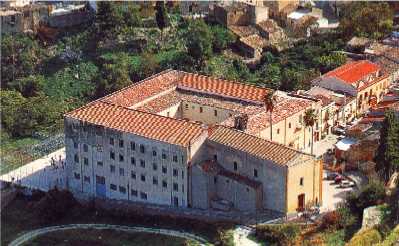

Maria Santissima di Tutte le Grazie, Mezzojuso's most ancient Byzantine-rite church previously called Vergine Maria Gloriosissima, whose Papįs welcomed Mezzojuso's first Albanian settlers in the 1460s. Attached is the large quadrangular Monastero Basiliano, founded in 1609 through a bequest by the Arbėresh noble Andrea Reres.
Photo: Courtesy of Giovanni Tavolacci, a Mezzojuso resident
On the northern perimeter of "la chiazza" are the two Catholic matriarchal churches of the Byzantine-rite and of the Roman-rite, or as the "Mezzojusari" say, "di rito greco e di rito latino". These churches are respectively: Saint Nicholas of Mira ("San Nicola di Mira") and Most Holy Mary of the Annunciation ("Maria Santissima Annunziata").
Mezzojuso's most ancient parochial church is generally considered to be the Roman-rite Catholic parish of Most Holy Mary of the Annunciation, "Maria Santissima Annunziata", rededicated in 1572. It was founded at about 1072 by the Normans, as the church of Most Holy Glorious Mary, "Maria Santissima Gloriosa", transforming the Saracen Arab mosque built a few decades earlier by Mezzojuso's indigenous Moslem inhabitants.
Just down the long straight street of via Andea Reres (toward the southwest, from the front door of my grandmother's house at "la fontana vecchia") is the church of Most Holy Mary of all Graces, "Maria Santissima di tutte le Grazie", with its attached Basilian monastery, "Il Monastero Basiliano".
I am sure that I must have gone into these various major Mezzojuso churches and the monastery during that summer of 1969, but I do not have any clear recollections of doing so. However, the little chapels of "La Madonna dell'Udienza" (the Madonna of Audience, or the Listening Madonna) and of "Santa Rosalia" (Saint Rosalie, the Norman princess and the traditional patron saint of Palermo), alongside the steep stone steps of "la Brigna" mountain (behind my grandmother's house), I very distinctly remember -- these small and very old chapels (nearly dilapidated) were apparently utilized for religious services only a few times per year.
Therefore, behind my grandmother's house were the cobblestone steps leading up to the top of "la Brigna" mountain, and in front of my grandmother's house was the old fountain ("la fontana vecchia") which is situated in the Piazza Corvino, named after Mezzojuso's past dynastic nobility, the Corvino family (1527-1832).



The Chapel of the Madonna of Audience, at the Stony Stairway of "la Brigna".
La Cappella della Madonna dell'Udienza, nelle Scale di Pietra "della Brigna".

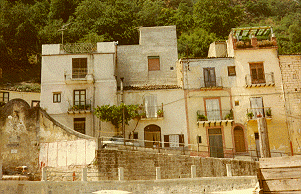

My Grandmother's House, above the Old Fountain and in Front of "la Brigna".
La Casa della Mia Nonna, sopra la Fontana Vecchia e nella Fronte "della Brigna".
My maternal grandmother's house is the central building, with the arched doorway having (to its left) the grape-vine pergola.

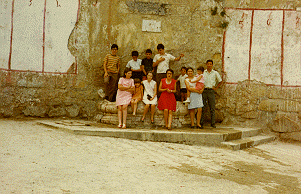

At the Old Fountain, My Cousins and My Brother and My Sister and Me.
Alla Fontana Vecchia, I Miei Cugini e Il Mio Fratello e La Mia Sorella e Me.
From left to right are: top row - Nicolo La Barbera, Tony Lagattuta (my brother), another Nicolo La Barbera, and Salvatore La Barbera; bottom row - Ana Napoli, Ina Napoli, Antonina Lucido, Franca Lucido, Lilo La Barbera, Domenica Lucido, Concetta Lagattuta (my sister), and me (Salvatore Lagattuta).
One of the activities that my relatives and family members and I used to enjoy very much was to go on picnics at "la Brigna" mountain or at some nearby family-owed country properties. These were leisurely excursions when we, bringing baskets of delicious food and drink, would walk by foot or drive by car, to certain pleasant pastoral places amidst well-kept farms and fields. Enjoyable and fun times, called "divertimenti", were playfully shared together by all participants during our picnicking activities. We were often asked, "Vi avete divertiti tutti?" ("Are you all having fun?") -- and we would answer (with some winks), "Si, ma non troppo!" ("Yes, but not too much!").

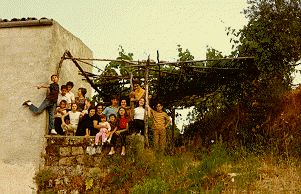

Picnicking at a Country House,
at a County Field, and at a Country Road.
Additionally, I fondly remember that I and my brothers and my cousins often climbed up the ancient, steep, stony steps of "la Brigna" -- through the woods right behind my grandmother's house (where a huge boulder as big as a truck had once tumbled down "la Brigna" mountain during an earthquake, nearly knocking into her house). We climbed the cobblestone stairway, sometimes nearly running breathlessly, until we reached the top of "la Brigna" -- for a breath-taking view of Mezzojuso and the surrounding countryside with its farms and wheat fields, a view where you could visually follow the main road leading down from Mezzojuso to the valley's far-away Highway 121 (which connects Palermo and Agrigento).
|
Mezzojuso: As seen from the summit of mount "la Brigna" during July, 1969. English version.
Mezzoiuso: Com'é visto dal culmine del monte "la Brigna" durante Luglio, 1969. Italian version.
Menzujusu: Comu é vistu da lu picu di munte "la Brigna" duranti Luliu, 1969. Sicilian version.
At the summit of "la Brigna" was a huge cross made of roughly hewn wood. As I recall, reportedly, various villagers from time to time would erect such a cross there; my father was noted as having built such a wooden cross atop "la Brigna", just before he emigrated from Mezzojuso to the United States in the spring of 1955.
Atop mount "la Brigna" was truly my favorite place in all of Mezzojuso!!! I loved the view, and I have always had a strange attraction to such "high places", even here in the U.S.A., such as atop Garrett mountain in Clifton, New Jersey, where you can even see New York City and its harbors, about 15 miles away. I think that it is rather symbolic to me, somehow. Perhaps there are "racial memories" -- of the Aragonese/Catalonians and of the Albanians in their lofty mountain abodes -- even as Shqiptarė (Albanian) and Spanish (Aragonese/Catalonian) blood flows through the veins of the "Mezzojusari".


![]()
![]()


![]()
![]()


"High places ..." I recall that while I was in Albania during April of 1993 (when Pope John Paul II re-established the Catholic hierarchy by ordaining four bishops in the Shkodėr cathedral, after more than 40 years of harsh communist rule), we Albanian-American tourists decided to go near the sea-coast city of Lezhė, in order to visit the nearly demolished Saint Stephen's church, an old place of pilgrimage for Albanian Catholics. This pilgrimage site with its church (slowly being reconstructed) is way up, on a craggy mountain, that overlooks an expansive valley far below -- with its many, many ("shum, shum" in Albanian) farms -- all the way out to the Adriatic sea about 10 miles away. It somehow reminded me very strongly of being at the top of "la Brigna" mountain, overlooking the fertile fields of Mezzojuso spread out below.


![]()
![]()


![]()
![]()


These are some of my remembrances, about visiting Mezzojuso during the summer of 1969.
Now, curiously, I recall that while I and my family were flying by airplane to Mezzojuso, the Apollo 11 astronauts were simultaneously traveling in a rocket ship on their way to becoming the first men on the Moon. It was my first airplane ride, where I could see the clouds and lands and waters way down below, although the astronauts' view was much higher up and (actually) much more spectacular. Both are observational views from "high places..." I had not thought about these things in years. While I and my family were thus traveling into our genealogical past (to Mezzojuso), the three astronauts were traveling into the technological future (to the Moon). Both directions from the present are important.
.
. |
Therefore, I will end with this observation:
"We need to more fully understand our past,
in order to better understand our future."
Tanti beddi cosi a tutti,

Salvuccio

(Salvatore Joseph Lagattuta)
![]()
![]()
![]()
![]()
![]()
![]()


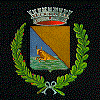


![]()
![]()
Discovering Our Mezzojuso Ancestry & Heritage
Blackburn, Mollye Bilao - - - "A Little of My Family History, and My Visit to Mezzojuso"; written on 20 April 1997. - - - "Cucidate: Fig Cookies for Christmas, A Mezzojuso Recipe"; written on 15 December 1997.
Briggs, Thomas - - - "My Family and I Visit Mezzojuso (during July, 1990)"; written shortly after the visit, and updated on 26 October 1997.
Cusimano, John - - - "My Trip to Mezzojuso (in the Province of Palermo)"; written on 7 November 1994.
De Angelo, Thomas - - - "My 'Discovery' of Mezzojuso"; written on 29 November 1999.
Di Stefano, Richard - - - "My Mezzojuso Immigrant Ancestors (Who Arrived in the U.S.A. in 1890)"; written on 1 November 1997.
Dunne, Laura Cutaia - - - "Genealogical Research on My Family from Campofelice di Fitalia"; written on 25 March 1999.
Frasca, Anthony - - - "Our Mezzojuso Reunion"; written on 10 May 1999.
Gallo, Frank - - - "Coincidence or Destiny? An Amazing Surprise during My Mezzojuso Research"; written on 29 April 1998.
Lagattuta, Salvatore Joseph - - - "My Family History from Mezzojuso"; written on 8 October 1999.
Lagattuta, Salvatore Joseph - - - "Remembrance of Visiting Mezzojuso (during the Summer of 1969)"; written on 26 April 1997.
Schiró, Anthony - - - "Mezzojuso Memories: Researching My Ancestry"; written on 26 October 1997.
Tavolacci, Giovanni - - - "I Soldati Garibaldini da Mezzojuso nel 1860" - "Garibaldi's Soldiers from Mezzojuso in 1860"; written on 12 April 1999. - - - "Campofelice di Fitalia e Mezzojuso" - "Campofelice di Fitalia and Mezzojuso"; written on 12 April 1999.
Mezzojusari, Descendants & Friends
|




![]()

![]()




![]()
![]()
![]()

![]() Home Page
Home Page![]() Main
Menu
Main
Menu![]() Discovering
Our Mezzojuso Ancestry
Discovering
Our Mezzojuso Ancestry![]()

![]()
![]()
![]()